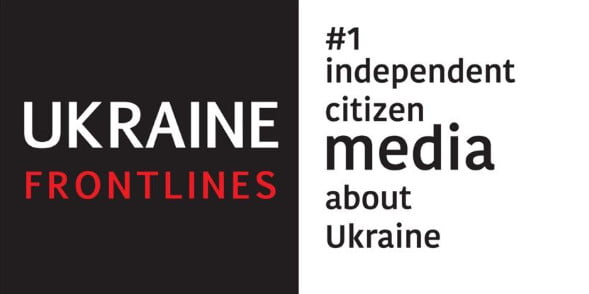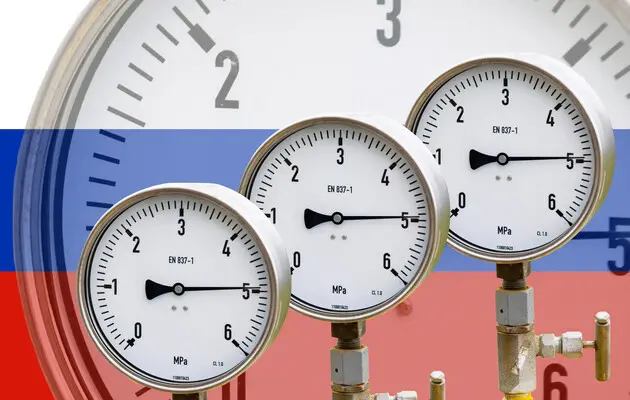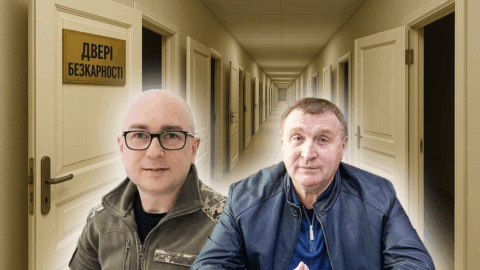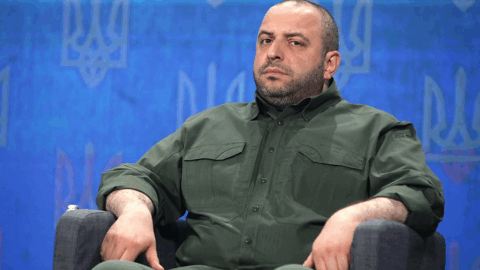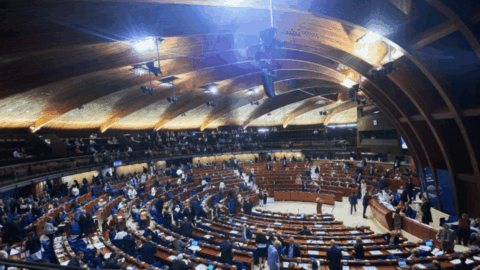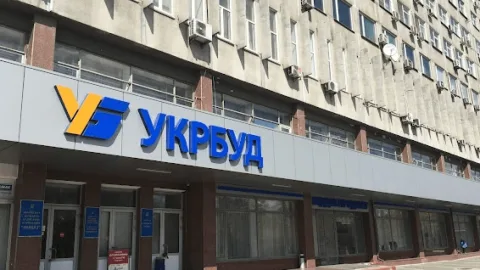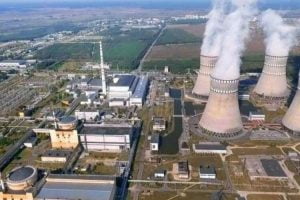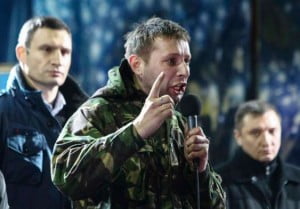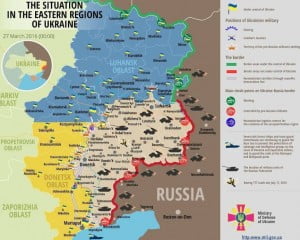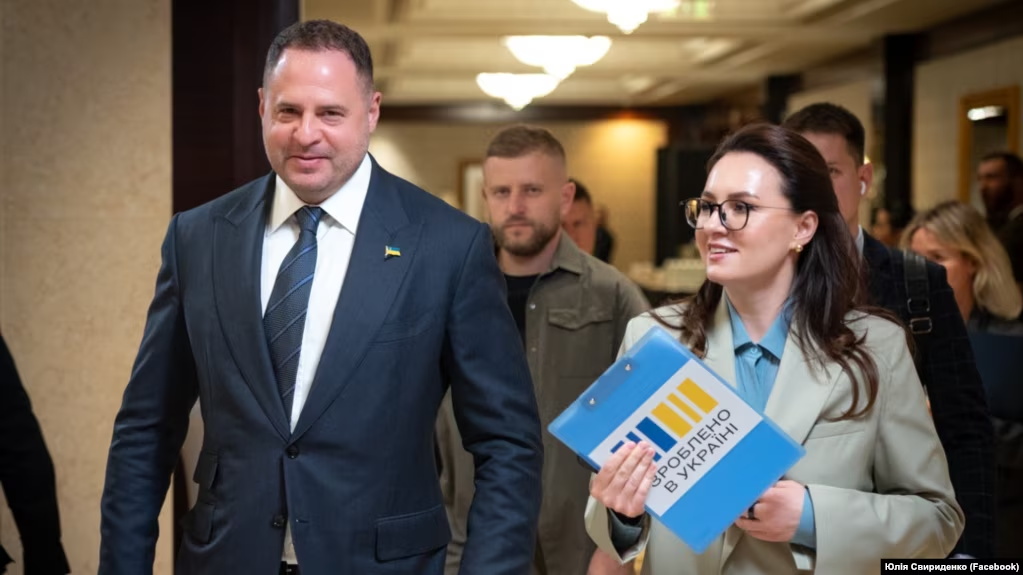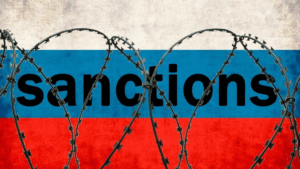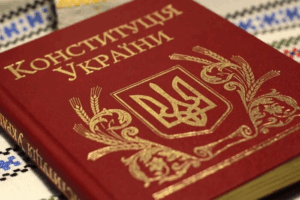Recently, the President of Ukraine Volodymyr Zelenskyy and those around him have increasingly expressed readiness to negotiate with the aggressor Russia.
At the same time, the topic of gas transit through Ukraine is gaining more attention in the media.
If you think these are two parallel processes, you are mistaken.
In non-Euclidean geometry, parallel lines intersect. In our case, these lines are set to intersect at a point called “gas corruption.” In this case we will speak about RosUkrEnergo.
Mikhailo Gonchar investigates.
A brief historical overview
If anyone celebrated the 20th anniversary of the Yalta meeting between the presidents of Ukraine and Russia, it was the “Viennese prisoner” Dmitry Firtash. On July 26, 2004, Leonid Kuchma and Vladimir Putin agreed on the settlement of natural gas supply and transit issues and announced to the business representatives present the founding of the company “RosUkrEnergo” (RUE), which was to resolve all bilateral problems in the gas sector. On July 29, a package of contracts was signed, extending for 25 years — until 2028 — and a coordinating council for the company was established in the Swiss canton of Zug. (At one time, “Mirror of the week” revealed all the schemes and documents related to RUE.)
But the Yalta meeting created more than just an elegant Swiss scheme. According to media reports at the time, the “Military Doctrine of Ukraine” was amended to remove the provision about Ukraine’s accession to NATO and the EU as the ultimate goal of Euro-Atlantic and European integration.
What followed after Yalta, as many may recall, was the Orange Revolution, which blocked Ukraine’s political drift towards Russia and prevented the establishment of a pro-Moscow regime in Kyiv. However, it did not stop the gas scheming, which Russia exploited: through the RUE scheme, the gas market of the country was effectively seized, gas prices were inflated for the state-owned Naftogaz of Ukraine, and in 2006 and 2009, two “gas attacks” were directed against Ukraine and the EU.
Subsequently, Russia, by fueling political opposition in Ukraine with “cheap gas” and replacing the RUE scheme with a bilateral agreement with onerous conditions for the Ukrainian company, caused political turbulence in our country. This eventually led to the rise of the pro-Moscow regionalist regime, with the Firtash–Boyko puppet group at its core.
The subsequent events included the Kharkiv agreements, the non-aligned status, Naftogaz’s loss to RUE in the Stockholm arbitration, the ruling regionalist faction led by Viktor Yanukovych’s rejection of European integration, and the logical outcome — the Revolution of Dignity, which toppled the pro-Moscow puppet regime of gasocracy and led to Russia’s aggression against Ukraine in 2014.
Everything new is well-forgotten old
The corrupt gas scheme, initiated and implemented by the KGB-FSB, worked brilliantly 20 years ago, although it did not last the allotted quarter-century. Of course, it can be noted that this was at a time when the Ukrainian economy was about three-quarters powered by Russian gas, and now the situation is radically different – only domestically produced gas is used, which meets the country’s needs by 100%. The dependence that existed was overcome back in 2015, when the last cubic meter of natural gas was imported from Gazprom on November 25. There is only a small amount of gas transit from Gazprom under the 2019 agreement, which is coming to an end this year, and it will not be extended.
“Gazprom” today is not the same Gazprom that was bursting with gas profits with generous dividend payments and the Swiss practice of elegant corruption through bearer shares. Russia’s “national treasure” is now unprofitable and in an extremely problematic financial condition, which is getting worse, even according to crooked official statistics. “Gazprom” has practically lost the EU market, it is not succeeding with China as well as it would like, Central Asia does not want large volumes of Russian gas, and Turkish extortionists are becoming unheard of, demanding ever greater discounts. But we shouldn’t forget that the general manager of Russian companies is sitting in the Kremlin and continues to operate according to the FSB methodology. He doesn’t know any other way, as the saying goes, only the grave will make a hunchback right.
Of course, a pure remake of RUE is impossible. But the point is that with a creative approach, you can make some modifications to the scheme, improve it and further disguise it. It is important to set the right task and turn Gazprom’s weakness into a trump card that can be used in the war against Ukraine and Europe, acting from within.
Trojan horses of the Kremlin at work
The sudden focus on the issue of gas transit from Russia is not coincidental, especially considering the imminent end of the agreement between Naftogaz and Gazprom. Moscow has been working on a dual plan to both save its “national treasure” and inflict damage on Ukraine well in advance. The strategy concerning Ukraine relies on the fact that those in power are somehow similar in spirit to the Yanukovych-era regionalists. These “young regionalists” are depicted as individuals for whom “nothing human is alien.”
The key is to package this strategy correctly. The right “packaging” includes a European and peacekeeping veneer. The latter is well-covered, with constant media reports that Russia is ready for negotiations, while Ukraine is not. The “European” aspect of the gas scheme is intended to be ensured by Russia’s long-standing Trojan horses within the EU and NATO — Hungary and Slovakia. The source of the transit gas should also leave no doubts about its origins — it must appear non-Russian.
And as we see, the pieces are falling into place. In June, there was a sudden emergence of media reports about Azerbaijan’s readiness to increase its gas supplies to the EU. It is likely that the Azerbaijani cover for Russian gas was discussed during the meeting between Putin and Aliyev on April 22, held to mark the 50th anniversary of the Baikal-Amur Mainline. This grand celebration was held with the Azerbaijani leader under the pretext that his late father, Heydar Aliyev, had overseen the construction. Behind the ceremonial event, however, the conversation was not about BAM…
Just a couple of weeks later, on May 7, a guest from the EU arrived in Baku. Slovak Prime Minister Robert Fico and Azerbaijani President Ilham Aliyev not only signed a declaration of strategic partnership but also discussed gas plans. Aliyev mentioned intentions to increase gas supplies to Europe from the current 8 billion cubic meters to 12 billion by the end of the year, with plans to reach 20 billion cubic meters by 2027. In response, Fico remarked, “Russia and Ukraine, for known reasons, can no longer export gas to Europe. We are naturally interested in supplying large volumes of gas to Slovakia. We are talking about approximately 20 billion cubic meters of gas per year. This will make a significant contribution to diversifying gas supplies to Europe.”
The funniest thing is that one side lacks the free gas resources (the Shah Deniz field has plateaued in production, and Shah Deniz-2 is largely a speculative venture), while the other side doesn’t need that much gas, as Slovakia consumes around 4.5 billion cubic meters per year. So, it’s clear what’s happening, even if it isn’t openly stated. The surplus gas actually exists and can be easily accessed if the transit scheme through Russia and Ukraine is utilized. Even though there is no direct pipeline from Azerbaijan to Ukraine, a substitution scheme will be used, and Russian gas will be disguised as Azerbaijani to flow into Europe.
From both Budapest and Bratislava, there have been voices indicating that these countries cannot manage without Russian gas and oil. Viktor Orbán has also joined the campaign, though more focused on the oil segment. But, competing with Fico, he decided not to lag behind in “active measures.” He unexpectedly and coincidentally appeared at the forum of the Turkic States Organization in Shusha, Azerbaijan, on July 6. Clearly, his participation was not solely about giving a flattering speech…
Meanwhile, in Ukraine
Few people paid attention to the official statement from Bankova following the phone call between Zelensky and Aliyev on May 21: “We have promising projects in energy, trade, and other areas. We instructed the teams to intensify their work on their implementation and coordinated future joint activities.” The Azerbaijani side noted that it was Zelensky who called Aliyev, not the other way around.
In mid-June, information began to appear in the media, including Russian outlets, about Azerbaijani gas for Europe transit through Russia and Ukraine. The presentation was such that: some “EU officials” were negotiating, and there were countries interested in Azerbaijani gas to replace Russian gas and save Ukraine’s gas transmission system (GTS), as it would not be able to operate without transit gas.
Initially, Kyiv did not comment on this. However, by early July, Zelensky himself confirmed that the agreement to replace Russian gas with Azerbaijani supplies was one of the proposals currently under discussion and that officials were working on it. “We are currently considering alternative steps on how we can use the pipeline with a different gas supplier, a different country. Negotiations are underway,” Zelensky said. “We do not want to extend the gas contract with the Russian Federation. We do not want them to make money here.”
Well, it sounds grandiose. However, the scheme involving “Azerbaijani” gas will not only keep Gazprom afloat but also provide additional revenue to Russia’s war budget against Ukraine. This revenue is expected to be in a ratio of about 1:10–15 (depending on EU market prices), meaning for every dollar paid to the Ukrainian operator for transit services by European customers of Gazprom, Gazprom will receive 10–15 dollars in revenue. Of course, Azerbaijan will also receive something in payment for providing “cover.”
“Where’s the scheme?” is the question. The scheme is that there will be no actual transit through Russia; rather, it will be a paper-based scheme with a substitution mechanism. The paper-based transit through Gazprom’s pipelines will be billed to a provider company under a hypothetical name like “Ros-Az-Ukrtansit-Gas,” registered somewhere in Switzerland or elsewhere. This payment for non-existent services will become a sort of “slush fund” for payouts to involved parties. Hence, the Slovakian Prime Minister painted a large number (of unnecessary) gas, supposedly so desperately needed by Europe.
What’s next?
The President of Ukraine is being pushed onto a slippery path of gas-related corruption, which will serve as grounds for new accusations and conclusions that Russian propaganda will use to sway our Western partners. They might say, for instance, that Ukrainians are once again seeking their familiar “gas paradise,” hence their willingness to engage in peace talks with the “aggressor,” and that Zelensky is no longer insisting on the withdrawal of Russian troops from Ukraine as a precondition.
It’s worth noting that the narrative being promoted in Ukraine’s information space is that without transit gas, several regions of the country could face shortages of blue fuel during the winter. Those advancing this narrative include not only individuals traditionally associated with the Firtash-Boyko group and “Gazprom” but also those who, perhaps unwittingly, are playing the role of useful idiots. They claim that extending the gas transit will serve as a safeguard against Russian attacks on gas transportation infrastructure.
In 2009, when Gazprom halted gas supplies both to Ukraine and Europe, the gas transmission system (GTS) was reversed to provide the country with domestically produced gas and from underground storage for two weeks during the peak of winter. There were no incidents of gas shortages in any regions. The previous management of the Gas Transmission System Operator of Ukraine conducted numerous simulations with American experts on how the GTS would function without transit gas. The conclusions were positive: the system would maintain its functionality. This is now being downplayed by Naftogaz.
Lastly, Russia, including recently in April-May, struck facilities at underground gas storage sites in Lviv region. This occurred while the transit contract was still in effect and Gazprom was receiving payments for selling Russian gas in Europe. This indicates that for the Kremlin, commercial goals of generating revenue are secondary; the primary aim is to damage Ukraine and Europe. These actions are signals not only to Kyiv but also to European companies using Ukrainian underground storage facilities, aiming to deter them.
As the saying goes, the road to hell is paved with good intentions. There is still time to stop and prevent these two parallel lines from intersecting. The path forward should lead to Ukraine’s victory, not to convoluted negotiations tainted with gas-related corruption and offering no guarantees. The negotiations in Qatar—another topic in itself—pose another trap for Ukraine’s defense forces, as Moscow seeks to limit Ukraine’s “deep strikes” on its territory while retaining the freedom to target Ukraine’s energy infrastructure.
Tags: Business peace plan peace summit peace talks Russia russia ukraine war russian agents Ukraine Volodymyr Zelenskyy